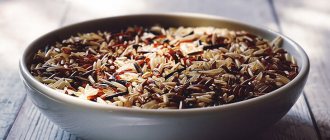© PixelsAway — depositphotos.com
Share:
The Metabolism Diet is one of the most versatile diets out there. On the one hand, the principle of this type of nutrition is extremely clear - “eat more often and you will be happy.” However, in reality it is not so simple.
Let's look at what a diet to speed up metabolic processes is and how to use it so as not to harm the body.
Acceleration of metabolism - influencing factors
Metabolic speed is influenced by many factors. They must be taken into account by anyone who intends to practice a diet to speed up metabolism.
We list the main influencing factors:
- Glycemic index of foods to avoid pancreatic failure.
- Glycemic load, which reduces the overall load on liver cells.
- The body’s initial preparedness for such a diet.
- Natural metabolic rate.
- Pursued goals. To gain weight you need one diet, to lose weight - a completely different one. Not only the calorie intake will differ, but also other indicators.
- Nutrient composition of the product.
- Balancing on a smaller level, be it the balance between Omega 3 and Omega 6 fats, or combining fast and slow proteins.
- The presence of additional factors that can slow down/speed up metabolism.
There are other factors that also affect metabolism, but these are the most important.
Before we continue talking about diet, let's debunk popular myths regarding metabolic processes.
© designer491 — depositphotos.com. Calculation of glycemic load
Calculate your metabolic rate
High-calorie nutrition alone will not help radically solve the problem. But one of the most important aspects of the issue is the determination of basic and active metabolism. This is necessary in order to correctly calculate the minimum individual calorie requirement.
Determination of resting metabolism
The basis for calculating daily food requirements is the determination of basic metabolism (basal metabolism). The latter demonstrates how many calories a specific person needs when he is at rest.
There are several formulas for determining BMR. The Harrison-Benedict formulas are most often used. There are several versions. We offer the latest, modified one.
For women:
447.593 + (9.247 * weight/kg) + (3.098 * height/cm) – (4.330 * age)
For men:
88.362 + (13.397 * weight/kg) + (4.799 * height/cm) – (5.677 * age)
Read also: Keeping warm in winter with drinks
An example valid for a 25-year-old man, 180 cm tall and weighing 63 kg:
88.362 + (13.397 * 63) + (4.799 * 180) – (5.677 * 25) = 88.362 + 844.011 + 863.82 – 141.925 = 1650 kcal/day. This is how much a young person with the specified parameters should consume.
But determining BMR is only part of the initial work. A healthy person does some kind of work one way or another. And any manifestation of physical activity is an expenditure of energy. Therefore, the next step is to determine the active metabolic rate (AMR). It will show what portion of calories a person needs in a particular case.
Calculation of daily calorie needs
Based on the degree of daily activity, the basic result must be multiplied by a certain coefficient:
- 1.2 – with low activity,
- 1.375 – with moderate physical activity, in relation to sports, people who exercise 1-3 times a week fall into this category,
- 1.55 – with intense energy consumption, this includes athletes who train hard 3-4 times every week,
- 1.7 – for heavy physical exertion, the basic metabolism should be multiplied by this coefficient either for people who play sports professionally or for those who engage in heavy physical labor,
- 1.9 – with very high energy consumption.
Let's return to the young man from the example. Let's assume that this is an ectomorph who goes to the gym 3-4 times a week. Then his active metabolism is: 1650 * 1.55 = 2557 kcal/day. By consuming food at the rate of 2500-2600 calories per day, a thin guy with these parameters will maintain a stable body weight.
Disregarding other factors that influence the degree of metabolism, we can assume that weight gain will occur if you increase your daily caloric intake. Unfortunately, manipulating metabolic rate requires a complex approach. Then the result will be more pronounced, and health problems will be avoided.
Myth One: Speeding up your metabolism helps you lose weight.
First, let's dispel the main myth regarding metabolism and weight. It is believed that accelerating metabolism promotes weight loss. This is wrong. Acceleration and normalization of metabolic processes are in no way related to weight.
If you speed up your own metabolic processes, the feeling of hunger will occur more often. For this meal plan to work for weight loss, you need to rev your metabolism just to create an artificial caloric deficit.
Excessive acceleration of metabolism will lead to exhaustion of the body, after which adaptation processes will return the body to its previous state. Moreover, often as a result of such acceleration various diseases appear. Metabolism will shift to catabolic processes with the accumulation of fat (source - “Textbook of sports nutrition”, Batyrev).
Conclusion: the rate of metabolic processes in the body does not affect the overall weight, it only adjusts the rate of weight gain/loss (source - Textbook “Sports Biochemistry”, Mikhailov).
© ersler — depositphotos.com
Essence and features
Metabolism is the process of breaking down substances received from food into small components and then combining them into components that are easily absorbed by the body. As a result, the synthesis of energy occurs, which is necessary for physical and mental work of a person.
When a large amount of food enters the body at the same time, which is also broken down into incompatible elements, the metabolism slows down, and the components that are not absorbed because of this are deposited in the form of fatty deposits. At the same time, the digestion process is also disrupted, which also does not have the best effect on the condition.
A diet to restore metabolism will not work immediately - the body will need some time to get used to rational functioning. Junk food consumed for years and even decades leaves its mark, which cannot be gotten rid of in a few days.
To understand whether there are problems with metabolism, you need to analyze whether the following symptoms are observed:
- brittle hair and nails, brittle teeth;
- painful skin color, dryness and cracks, especially on the heels;
- bowel disorders;
- persistent swelling in different parts of the body, regardless of the amount of fluid drunk; dyspnea;
- strong cravings for sweet foods, especially after lunch.
Metabolism can be slowed down not only due to eating junk food.
Important . In 2% of cases, the root of all evil turns out to be problems with hormonal levels, so before going on a diet to normalize metabolism, you should make an appointment with a doctor and undergo an examination.
If someone who wants to lose weight really has a disease that will not be treated, then no methods to speed up metabolism will give a positive result.
Myth two: slow metabolism is bad
The second misconception that people who are far from sports and a healthy lifestyle adhere to: “I have a slow metabolism - this is bad.”
There are several types of metabolism:
- fast;
- accelerated;
- normal;
- balanced.
A fast metabolism is completely natural for many people. That is, if you are genetically inclined to a fast metabolism, you do not need to speed it up or slow it down, you need to adapt to its characteristics, and thereby get the maximum benefit from your type of structure.
Accelerated metabolism – out of balance. Yes, you artificially accelerate metabolic processes and make them faster than nature intended. However, sooner or later the metabolism will still slow down.
Balanced metabolism is the stage that follows any sudden disturbance in the rate of metabolic processes. It doesn’t matter whether you artificially accelerated your metabolism in order to lose weight, or, on the contrary, slowed it down in order to save the energy component in your muscles after completing a course of anabolic hormones.
A balanced metabolism is a natural return to normal.
If you're looking to lose weight/gain muscle, you don't need to speed up your metabolism or balance it out. You just need to normalize metabolic processes (for this there are separate nutrition plans with their own principles).
Principles of creating a nutrition plan
Diet itself does not guarantee results.
It is important to comply with the following conditions:
- Sufficient mobility. This can be either training with iron or simply long and intense walks. This is necessary so that the body has time to spend accumulated energy and improve energy metabolism in all structures of the body.
- Full sleep. During sleep, all metabolic processes are activated. Artificially slowing down metabolic processes temporarily balances the body, thereby allowing for additional acceleration during the day.
- Don't forget about the balance between anabolic and catabolic processes.
Now let's move on to building a nutrition plan to speed up metabolism in order to quickly get rid of fat reserves in the body.
These rules will help speed up your metabolism to the limit, and do it as quickly as possible:
- Eat more often. It doesn’t matter whether you increase the total calorie intake or, on the contrary, cut it. Try to eat at least 6-7 times a day. This will speed up metabolic processes by an average of 70%. This is already enough for many people with slow metabolism. However, it is not necessary to serve yourself a full plate every time. You can afford a full lunch, and eat one apple for the remaining 5-6 meals.
- Eat separately. Fermentation of food occurs due to the secretion of special secretions in the stomach. If you strive for separate nutrition, the body will be able to prioritize the release of enzymes, which will speed up the digestion of food and reduce the load on the liver and gastrointestinal tract. In turn, this means that such food will have a higher GI and lower GL.
- Chew, don't swallow. No matter how strange it may sound, the truth familiar from childhood that you need to chew food thoroughly really affects your metabolic rate. Chewing signals the stomach that food will soon begin to enter the body. The stomach begins to actively secrete digestive secretions, which stop being produced immediately after swallowing. In addition, chewing leads to the fact that complex carbohydrates dissolve into simple ones, up to their conversion into glucose.
- Eat less fatty foods. The amount of fatty acids, incl. trans fats should not exceed 15-20% of the total calorie intake. All this is due to the fact that fats require additional transport proteins, the lack of which can completely reduce the rate of metabolic processes to almost zero for some time.
- Liquid, liquid and more liquid. Fluid affects the overall level of primary urine and blood clotting. Of course, you should not increase your water consumption to 8 liters. It is enough to drink 2-3 liters of water, not counting liquids from soups, coffee and tea. In this case, the body’s desire to normalize the water-salt balance will lead to an acceleration of metabolic processes.
- As many simple carbohydrates as possible. Try to include carbohydrates at every combination meal. The simpler they are, the faster your metabolism will accelerate. If your goal is to gain weight, don't limit yourself. If you are considering accelerating your metabolism for the purpose of losing weight, carefully monitor the calorie content of the carbohydrates included in your diet.
- Shift the metabolic scales towards anabolism. Only by maintaining a high level of anabolic reactions will you maintain a high metabolic rate. To do this, you need as many fast “whey” proteins as possible.
Recipes
Breakfast is the hardest thing to prepare because you never have time for it. Here are simple and affordable recipes for each phase in the morning.
Oatmeal smoothie for the first phase
You need to take:
- 0.5 cups oatmeal;
- 0.5 cups of fresh or frozen fruit;
- 1 glass of water.
First, you need to grind the flakes in a blender, and then add the rest of the ingredients and grind again. Season to taste with cinnamon and stevia and breakfast is ready in 5 minutes.
Omelette with vegetables for the second phase
Required ingredients:
- 1 onion;
- 0.5 cups chopped spinach;
- 2 champignons;
- 3 egg whites.
Simmer the chopped onion in a frying pan without oil, add spinach and chopped mushrooms. Add the whites to the vegetables and fry, stirring constantly until cooked.
Quick tuna salad with vegetables for the second phase
You need to take:
- 1 can of canned tuna in its own juice;
- 3 pickled cucumbers;
- 1 large red onion;
- a few basil leaves;
- 2 cups shredded cabbage.
For dressing 2 tbsp. lemon juice, 1 tbsp. mustard, ground black pepper to taste.
All you need is to chop the greens and vegetables, drain the liquid from the tuna and mash it with a fork. Combine all ingredients and season salad.
Oatmeal with nuts and berries for the third phase
List of required products:
- 1 cup oat flakes;
- 2 glasses of water;
- 0.5 cups of berries;
- 0.5 cups of mixed nuts and seeds.
Add the flakes to boiling water, boil for 15 minutes, remove from heat. After 10 minutes of infusion, add berries and nuts. Simple, tasty and satisfying.
Lifehacks
Additional life hacks that will help dramatically speed up metabolic processes in the body will be products that directly affect their course.
- Caffeine products. Caffeine is not only a powerful fat burner. Its main effect is to accelerate the heart muscle, which increases the speed of blood flow through the vessels, and as a result, changes the metabolic balance.
- Adrenaline stimulants. These include things like taurine, ephedrine, clenbuterol, salbutamol, etc. Of course, they are not suitable for speeding up metabolism for the purpose of gaining weight, but they can speed up metabolism in the short term. Adrenaline is a powerful optimizer that triggers catabolic processes with a large release of energy, but does not slow down metabolic processes at all.
- Protein shakes. Protein shakes are primarily made from fermented and dried whey protein. This, in turn, practically does not load the stomach, however, the absorption of protein still releases glucagon and insulin, which in turn, in the absence of gastric digestive secretions, forces a person to eat. Some time after taking a protein shake, you need to close the suddenly formed carbohydrate window, which in turn leads to a cumulative increase in the number of meals.
- Foods rich in vitamin C. Vitamin C is a powerful acid that directly affects digestive processes, accelerating them, thereby increasing the speed of metabolic processes in the body. Attention - if there is an excess, a spasm of the gastric tract is possible.
- Foods with negative calories. These are usually green vegetables that are rich in fiber, which is difficult to digest. If they are consumed separately from proteins and carbohydrates, then the body’s attempts to break down fiber will lead to an uncontrolled release of digestive secretions, which will increase the speed of metabolic processes.
- Combining foods with different digestion rates. A simple example is junk food. Mix trans fats with fast carbohydrates. The result is rapid deposition of adipose tissue with a high metabolic rate. But this does not mean that you need to combine harmful products. It is enough to add 2-3 cubes of sugar to each meal after 15-20 minutes.
What should you consider when deciding to lower your metabolism?
An artificial decrease in metabolism is stressful for the body. The consequences may be the following:
- the body will try to enter and exit its usual metabolism, and this can lead to excessive metabolism in the future;
- resources are optimized, and a person’s physical activity slows down.
In the short term, there may be a decrease in brain activity and increased production of stress hormones. Drowsiness, irritability, changes in daytime cycles and reduced stamina become common occurrences. There may be a decrease in the normal functioning of internal organs. And this affects the occurrence of various chronic diseases.
In the long term, the synthesis of hormones is disrupted, the hormonal balance is rearranged, and a gastric ulcer may develop. The level of insulin in the blood changes, and fatty degeneration of the liver occurs. Atherosclerosis and coronary heart disease are becoming common. That is why you should not get carried away with artificially reducing immunity. It's better to approach this wisely.
Foods to speed up metabolism
Products that help speed up metabolism should have the following characteristics (source - Wikipedia):
- Maximum reduced glycemic load.
- Relatively high glycemic index.
- Contain a huge amount of cholesterol.
- Contain a lot of water in its composition.
- Their caloric content should be half of the one-time norm.
- Less fatty foods, more carbohydrates.
- Proteins are preferably quickly digested (dairy products).
© Daxiao_Productions — depositphotos.com
Remember, if you finish a meal feeling slightly hungry, you will continue to speed up your metabolic processes. If you eat too much every time, then in an attempt to digest a huge excess of calories in food, your metabolism will gradually slow down, since under the influence of insulin, the body, which will not be able to spend all these calories, will open a fat depot. And even if you have an extremely accelerated metabolism, in the end you will only gain excess fat faster.
| Product | Water | Squirrels | Fats | Carbohydrates | Calorie content |
| Eggplant | 82.0 | 0.6 | 0.2 | 5.5 | 24 |
| Baranki | 26.0 | 20.4 | 2.4 | 68.6 | 422 |
| Cow's milk cheese | 52.0 | 26.8 | 20.2 | 0.0 | 260 |
| Swede | 86.5 | 2.2 | 0.2 | 8.2 | 46 |
| Green peas | 80.0 | 5.0 | 0.2 | 24.4 | 62 |
| Natural yoghurt 2.5% fat | 88.0 | 5.0 | 2.5 | 4.5 | 52 |
| Zucchini | 84.0 | 0.6 | 0.4 | 5.6 | 26 |
| White cabbage | 80.0 | 2.8 | – | 5.4 | 28 |
| Red cabbage | 80.0 | 2.8 | – | 6.2 | 42 |
| Cauliflower | 80.8 | 2.5 | – | 4.8 | 28 |
| Potato | 66.0 | 2.0 | 0.2 | 28.6 | 84 |
| Full fat kefir | 88.4 | 2.8 | 4.2 | 4.2 | 58 |
| Low-fat kefir | 82.4 | 4.0 | 0.2 | 4.8 | 40 |
| Green onion (feather) | 82.5 | 2.4 | – | 4.4 | 22 |
| Leek | 86.0 | 4.0 | – | 6.4 | 40 |
| Bulb onions | 86.0 | 2.6 | – | 8.5 | 44 |
| Milk | 88.5 | 2.8 | 4.2 | 4.6 | 58 |
| Acidophilus milk | 82.6 | 2.8 | 4.2 | 20.8 | 84 |
| Condensed milk | 64.2 | 6.0 | 6.8 | 8.5 | 245 |
| Condensed milk with sugar | 26.5 | 6.2 | 8.5 | 56.0 | 425 |
| Whole milk powder | 4.0 | 25.6 | 25.0 | 48.4 | 465 |
| Red carrots | 88.5 | 2.4 | 0.2 | 6.0 | 44 |
| Wheat flour, grade I | 24.0 | 20.6 | 2.4 | 64.2 | 428 |
| Wheat flour, grade II | 24.0 | 22.6 | 2.8 | 60.8 | 428 |
| Premium wheat flour | 24.0 | 20.4 | 0.8 | 64.2 | 426 |
| Rye flour | 24.0 | 6.8 | 2.2 | 66.8 | 426 |
| Ground cucumbers | 85.0 | 0.8 | – | 4.0 | 25 |
| Greenhouse cucumbers | 86.5 | 0.6 | – | 2.8 | 20 |
| Sweet green pepper | 82.0 | 2.4 | – | 4.6 | 24 |
| Sweet red pepper | 82.0 | 2.4 | – | 5.6 | 26 |
| Parsley (greens) | 85.0 | 4.6 | – | 8.2 | 45 |
| Parsley (root) | 85.0 | 2.5 | – | 22.0 | 46 |
| Curdled milk | 88.4 | 2.8 | 4.2 | 4.2 | 58 |
| Rhubarb (petiole) | 84.5 | 0.6 | – | 2.8 | 26 |
| Radish | 84.0 | 2.2 | – | 4.2 | 20 |
| Radish | 88.6 | 2.8 | – | 6.0 | 44 |
| Turnip | 80.5 | 2.5 | – | 5.8 | 28 |
| Ryazhenka | 85.4 | 4.0 | 6.0 | 4.2 | 85 |
| Butter pastries | 26.2 | 6.6 | 4.5 | 60.0 | 286 |
| Butter pastries | 26.2 | 6.6 | 4.5 | 60.0 | 286 |
| Cream 20% | 62.8 | 2.8 | 20.0 | 4.6 | 205 |
| Sour cream 20% | 62.6 | 2.8 | 20.0 | 4.2 | 206 |
| Wheat crackers | 22.0 | 22.2 | 2.4 | 62.4 | 442 |
| Cream crackers | 8.0 | 8.5 | 20.6 | 62.4 | 486 |
| Drying | 22.0 | 22.0 | 2.4 | 64.0 | 440 |
| Dutch cheese | 48.8 | 26.8 | 26.4 | 0.0 | 462 |
| Processed cheese | 55.0 | 24.0 | 24.5 | 0.0 | 226 |
| Poshekhonsky cheese | 42.0 | 26.0 | 26.5 | 0.0 | 444 |
| Russian cheese | 40.0 | 24.4 | 40.0 | 0.0 | 462 |
| Swiss cheese | 46.4 | 24.8 | 42.8 | 0.0 | 486 |
| Special cheeses and curd mass | 42.0 | 6.2 | 24.0 | 26.5 | 440 |
| Fat cottage cheese | 64.6 | 24.0 | 28.0 | 2.4 | 226 |
| Low-fat cottage cheese | 66.6 | 28.0 | 0.6 | 2.5 | 86 |
| Wheat bread from grade I flour | 44.4 | 6.6 | 2.4 | 54.4 | 254 |
| Rye bread | 42.4 | 4.6 | 0.6 | 48.8 | 224 |
Products to exclude
During the diet, you should not eat smoked products, pickles, baked goods and fried foods, as well as the following products:
- corn, in any form: cereal, canned, boiled;
- sugar, honey, instead of them only sweeteners;
- sweet fruit juices and dried fruits;
- dairy products;
- coffee, tea, any caffeine-based drinks;
- alcohol;
- soy,
- wheat;
- solid fats (butter, margarine) and refined oils.
Salt is also subject to restrictions, but the bland taste can be compensated for by adding herbs, spices, and spices. They are allowed during the entire period of weight loss.
Another commercial joke - Hayley Pomeroy's diet
What is the essence of Hayley Pomeroy's phased diet?
It has two basic principles:
- Simplification of nutrition principles. It all comes down to a simple menu for every day.
- A severe caloric deficit that does not take into account the basic needs of the body
Is this diet harmful? Of course, yes, since a strict connection to calorie content often leads to hunger, and as a result to maximum inhibition of metabolic processes . However, if you look at the menu, adjust the calories and take a close look at the basic principles, you will notice that they are not at all different from those presented in this article.
In particular, Pomeroy recommends:
- The principle of separate nutrition.
- Drinking large amounts of protein shakes (CFD shakes), which are actually designed to slow down catabolism and reduce the effects of a fixed calorie intake.
- Increasing the number of meals.
- The presence of a large number of foods with excess vitamin C on the menu.
- Water.
However, the phase periodization used by Pomeroy is not suitable for most people, since it does not take into account the individual characteristics of the body. In this case, the first phases “aimed at calming the adrenal glands” can lead to a slowdown in metabolism and a decrease in the secretion of digestive enzymes, which after the end of the 4-week cycle, in an effort to balance metabolic processes, will lead to a sharp decrease in the metabolic rate in general.
© belchonock — depositphotos.com
Recipes for healthy eating
DIY energy bars
- 15.9 g Protein
- 15.6 g Fat
- 20.6 g Carbohydrates
- 245 kcal
15-25 min.
- #peanut
- #vegetarian dish
- #for vegans
- #cocoa
- #cashew
- #coconut flakes
- #almond
- #snack
- #dates
Other recipes
Contraindications and possible side effects
This diet is quite balanced in terms of proteins, fats and carbohydrates. There should also be no lack of vitamins due to the abundance of vegetables and fruits. However, it may be necessary to supplement it with calcium supplements.
Due to the ban on dairy products and the low caloric content of the diet, it is contraindicated for pregnant and lactating women. This nutritional system is also not suitable for people with diseases of the endocrine system. It should not be practiced by those under 18 or over 60.
Side effects may include weakness, especially in people with hypotension, and dizziness.











